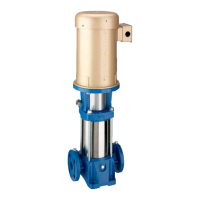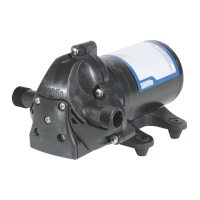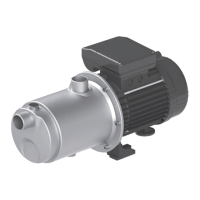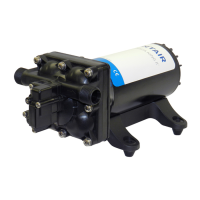4
Do not operate the pump without liquid. Pump seals or
packing depend on the liquid being pumped for lubrication.
Be sure the pump is primed and that no air exists in the suction
pipe and pump casing.
MAINTENANCE
Your Aurora
®
pump requires no maintenance other than
periodic inspection, lubrication and occasional cleaning. The
intent of inspection is to prevent breakdown, thus obtaining
optimum service life. The motor may require lubrication. The
motor manufacturer’s recommendation should be followed. For
all of the split case pump models, regreasable bearings are
standard. Oil lubrication is optional on the 431B pumps.
Regreasable bearings will require periodic lubrication and can
be accomplished by using the zerk or lubrication fittings in the
cartridge cap. Lubricate the bearings at regular intervals using a
grease of high quality. Aurora recommends Chevron SRI No. 2
grease with a polyurea thickener. However, most major brands
of Grade No. 2 ball bearing grease are satisfactory for pumps
oper at ing in both wet and dry locations. Mixing of different
brands of grease should be avoided due to possible chemical
reactions between the brands which could damage the bearings.
Accordingly, avoid grease of vegetable or animal base which
can develop acids, as well as grease containing rosin, graphite,
talc and other impurities. Under no circumstances should grease
be reused.
Overlubrication should be avoided as it may result in overheating
and possible bearing failure. Under normal application, adequate
lubrication is assured if the amount of grease is maintained at 1/3 to
1/2 the capacity of the bearing and adjacent space surrounding it.
In dry locations, each bearing will need lubrication at least
every 4,000 hours of running time or every 6 to 12 months,
whichever is more frequent. In wet locations the bearings
should be lubricated at least after every 2,000 hours of running
time or every 4 to 6 months, whichever is more frequent. A unit
is considered to be installed in a wet location if the pump and
motor are exposed to dripping water, to the weather, or to heavy
condensation such as is found in unheated and poorly ventilated
underground locations.
Oil lubricated bearings are optional on Model 431B pumps. A
fixed oil level is maintained with the bearing cartridge by an
oiler which allows visual indications of reserve oil.
At initial installation and before starting, a unit that has been
shut down for repairs or for any extended length of time, run
enough 10W-20 weight motor oil through the oiler to maintain
a constant oil level to ensure that the bearing will never be
without an oil supply. Oil will have to be added at intervals to
maintain a constant level in the oiler. This interval can be
determined only by experience.
Under working conditions, oil will break down and need to be
replaced at regular intervals. The length of these intervals will
depend on many factors. Under normal operation, in clean and
dry locations, the oil should be changed about once a year.
However, when the pump is exposed to dirt contamination, high
temperatures (200°F or above) or a wet location, the oil may
have to be changed every 2 to 3 months.
At times it may be necessary to clean the bearings due to accumulated
dirt or deteriorated lubricants. This can be accomplished by flushing the
bearing with a light oil heated 180 to 200ºF while rotating it on a spindle.
Wipe the bearing housing with a clean rag soaked in a cleaning solvent
and flush all surfaces.
Dry bearing thoroughly before relubricating. Compressed air
can be used to speed drying, but care should be taken not to let
bearings rotate while being dried.
Use normal fire caution procedures when using any
petroleum cleaner.
The motor that drives your Aurora pump may or may not require
lubrication. Consult the manufacturer’s recommendations for proper
maintenance instructions.
REPAIRS
The pump may be disassembled using the illustrations and text
provided. Although complete disassembly is covered, it will
seldom be necessary to completely disassemble your Aurora pump.
The illustrations accompanying the disassembly instructions
show a Model 411 pump at various stages of disassembly. The
illustrations are intended to aid in the correct identification of
the parts mentioned in the text.
Refer to Figure 6 that illustrates the various pump models
described in this manual.
Inspect removed parts at disassembly to determine if they
can be reused. Cracked castings should never be reused. All
optional packing and gaskets should be replaced at reassembly
simply as a matter of economy. They are much less expensive to
replace routinely than to replace singly as the need arises. In
general it is economical to return to the manufacturer for repair
to the motor and motor controller.
DISASSEMBLY
Disassemble only what is needed to make repairs or accomplish
inspection. Proceed to disassemble the pump as follows:
CAUTION
Figure 6. The models shown above are single stage pumps in various
mounting configurations.
MODEL 412
MODEL 413
MODEL 411
CAUTION
MODELS 411-412-413

